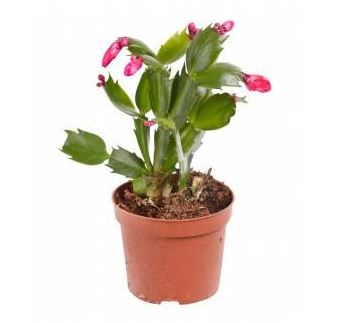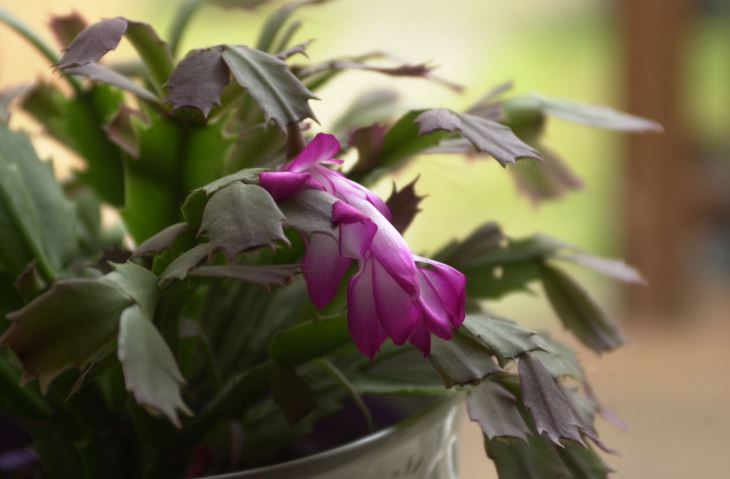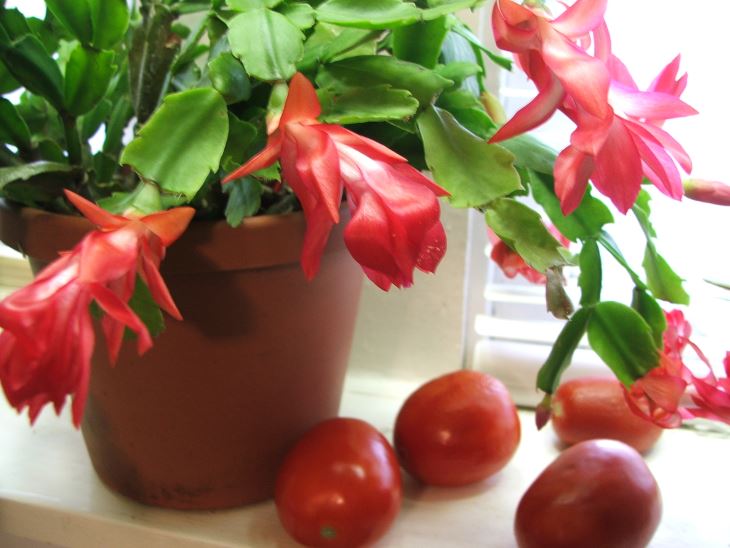The Christmas Cactus possesses a scientific name which belongs to a genus that has a confusing history - to say the least. The plant currently belongs to the Schlumbergera genus, and has the botanical name of (Schlumbergera bridgesii – synonym: S. × buckleyi - hybrid) from the parent plant named Schlumbergera Truncata. Adding to this confusion is the fact that many
synonyms for the species are used and the change in genera.
The parent plant of the Christmas Cactus (this is a hybrid) is native to South America that grows in the mountains of Brazil. It's tropical nature commonly confuses growers
into offering too much heat and light, without enough water.
How It Looks: This cactus produces small, flat stem segments that are roundish in nature, with minor serrations on both sides. They
flower from the end of these segments. The Christmas variety has neon pink pollen-bearing stamen. Along with the December blooming
preference, this is the Cactus's defining feature.
Flowering: The flower produces a unique, tube-shaped "double flower" appearance, with the "outer" flower being formed by shorter leaves
that curl back near the flower's base, and the "inner" flower being formed further up the flower, near the stamen. They bloom from mid-November and January.
If temperatures are kept steady near the 68°F (20°C) mark, flowering can continue for eight weeks or more. To induce flowering
for the coming year, place your Christmas Cactus in a dark room for 12-14 hours on fall nights. For best flowering results, pinch off any
plant segments less than 1 cm long in early September.
Facts
Origin:
Brazil.
Names:
Christmas and holiday cactus (common). Schlumbergera Bridgesii, S. × buckleyi(botanical/scientific).
Max Growth (approx):
Height 10 in/25.4 cm, diameter 24 in/61 cm.
Poisonous for pets:
Non-Toxic to cats and dogs.

Close up of Christmas Cactus

Red Flowers

Christmas Cactus Care
Resting Period:
This cactus requires a resting period that helps it to bloom again, from Feb - March. During this time keep temperatures at approximately 55°F (12.7°C) and water less. Pre - flowering period from Oct - Nov requires the plant soil to be kept fairly dry until flowers bud, and then resume normal watering and temperatures.
Temperature:
Temperature: Best kept at 68°F (20°C), although fluctuations from 60-70°F (15-21°C) are tolerated. The plant can be
kept at 55-59°F (13-15°C) will grow slowly and allow rest. Plant death can occur at below 50°F (10°C).
Light:
During the late fall and all winter long these plants like full, direct sunlight. At any other time of the year, the plants should be grown in partial sun conditions. Too much light during non-flowering times will cause the plant to turn yellow and fail to produce buds in the coming year.
Watering:
Although a cactus, this is a tropical plant. The top inch of soil should be kept moist to the touch at all times. Never allow the soil to become water-logged, or permit water to stand in the pot tray.
Soil:
The Christmas Cactus likes being grown in pots. It demands an easily drained growth medium. Suggested is a mixture of 60% potting soil with a pH balanced formula and either 40% bark or 40% perlite.
Fertilizer:
They likewise require a high dose of magnesium in the soil for proper growth, which is achieved through a mixture of 1 teaspoon Epsom salts to 1 gallon of water. This must be delivered to the plant on a monthly basis from early spring through early fall, and should be given two weeks after a regular fertilizer treatment for best results.
Re-Potting:
This is best performed in the late spring season. Place the cactus with plenty of room in the container. Re-potting is required every three years to provide additional growth room, although they do prefer being partially pot-bound.
Humidity:
Normal room humidity is suggested for this plant. Mist leaves frequently.
Propagation:
Best propagated through the cutting method. Sections of stem tip's at least 3 segments long should be removed from the main plant. These must be left to dry for theree or four days. Combine the three cuttings and place at least one inch deep in soil. For best results, cuttings should be taken in early summer.
Potential Problems
- Temperatures must always be kept above 50°F (10°C) or any forming or flowering buds will drop off the plant.
The soil must be kept moist at least one inch down, or the cactus segments will shrivel and die.
More suitable plants
grown indoors for Christmas »








